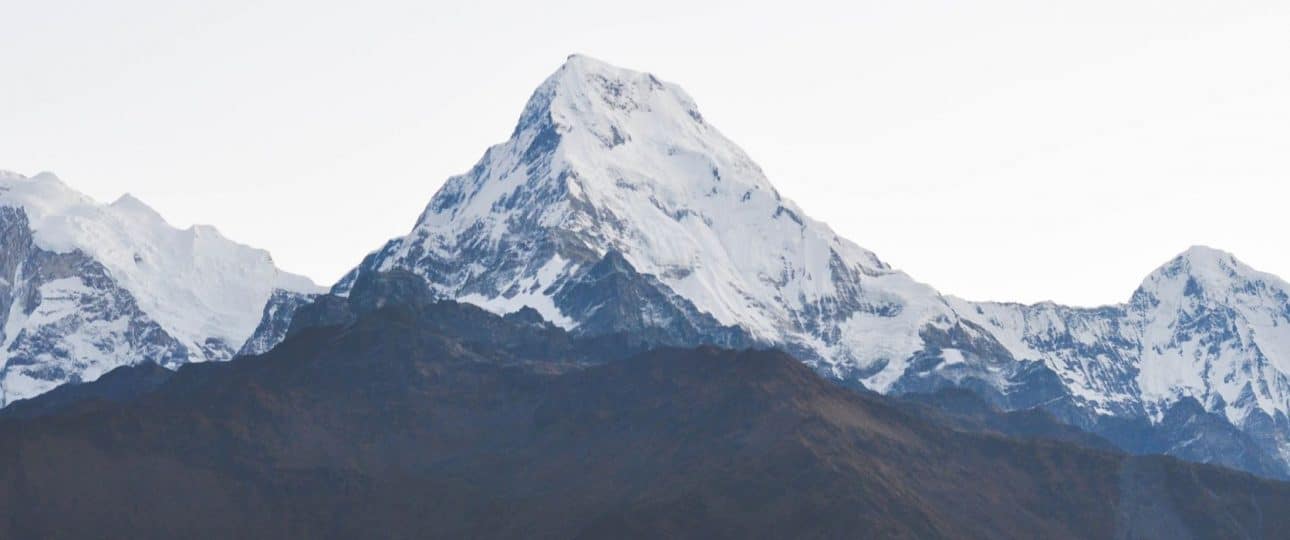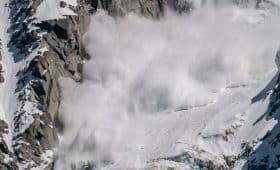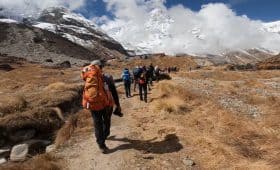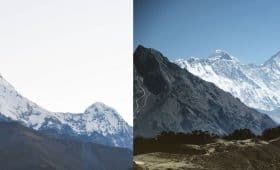Read this Annapurna Base Camp training guide further for comprehensive information to prepare yourself for an enjoyable trip to one of the popular trekking destinations in Nepal.
The trek up to the base camp of Mt. Annapurna is like once in a lifetime trip. But to achieve this once in a lifetime trip you need to follow some training before the actual Annapurna Base Camp Trek.
Annapurna Base Camp Trek offers amazing views of the snow-covered peaks with the surrounding landscapes and this 9-day long hike takes you to interesting landscapes.
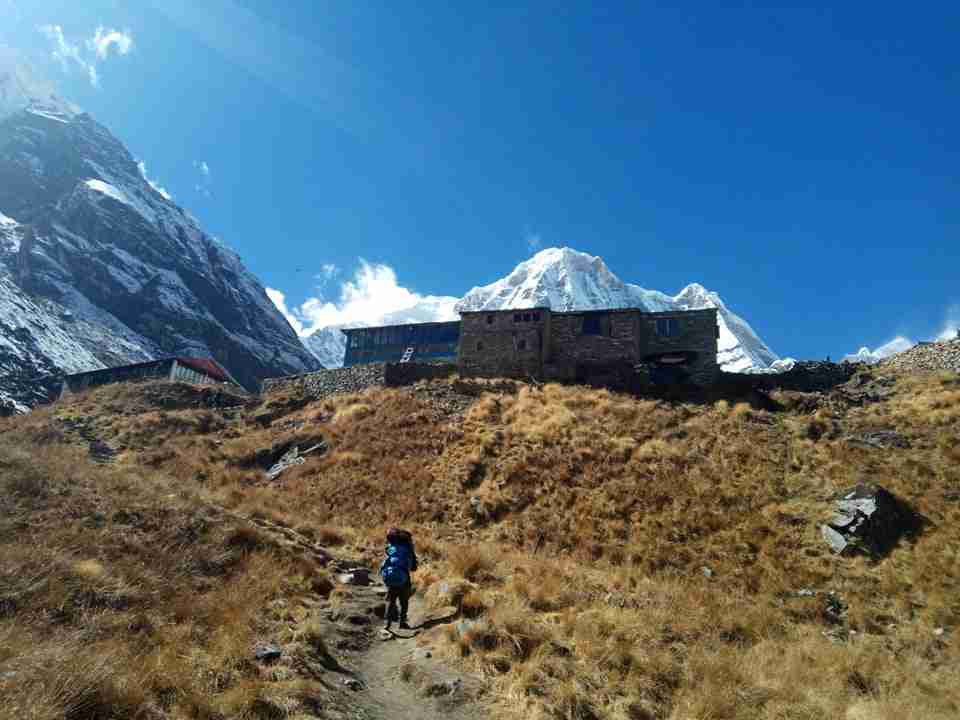
The Annapurna Base Camp trek begins near the town of Pokhara and passes via rhododendron forests, alpine, and glacial terrain.
The popular Annapurna Base Camp trek is a moderate level 9 days trek. On this trek, you reach the maximum height of 4,110 m above sea level.
So, you may find breathing more difficult and more physically demanding as you ascend higher.
For such a long trip ascending to high altitudes, you surely need to know how fit you need to be to hike Annapurna Base Camp trek.
And, you must be prepared and well trained for the activity that you’re undertaking.
Trekking up a mountain or just hiking across in the countryside is a wonderful activity that everyone should indulge in.
Believe me! It can be a rewarding experience, even life-changing.
At the same time, it can be also painful, hard and exhausting. It all depends on your mindset and your fitness.
Also, you don’t want to be the one who slow down your group member on the trail.
So, training is a matter of pride and preparedness.
By following proper training program for Annapurna Base Camp trek, you’ll reduce the probability of getting injured, and feeling tired on the trail.
So here, I have some Annapurna Base Camp trek training tips for you!
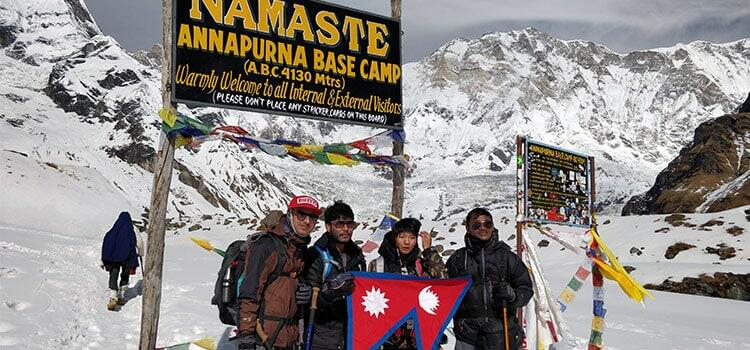
Table of Contents
Aerobic Training (Cardiovascular)
With the increase in altitude, the oxygen level in the atmosphere gradually starts decreasing.
And, when you are trekking in such a thin air your heart is pumping hard to release oxygen and blood to the whole body.
Your heart needs to work double to make your body function properly.
So, before heading on the trail, aerobic exercises is number one thing you need to pay attention.
If you’re a beginner, then it is better to start preparing yourself 6 months prior to the trip.
Whether you intend to do short day hikes or multi-day hiking, you must require a good cardiovascular endurance.
Aerobic means requiring free oxygen. It refers to use of oxygen to adequately meet energy demands during exercise via aerobic metabolism.
Aerobic exercise mostly involves light to moderately intensive activities such as cycling, swimming, running, or any other activity that gets your heart and lungs pumping.
Basically, aerobic exercise will help to adopt the maximum volume of oxygen that your body can use. This is very important for the trek.
As you gain altitude there will be less oxygen in the air for you to consume and each breath counts.
Alternatively, it’s also good to include hill training in your cardio training.
If you’re one of those people who go to the gym regularly, you can keep going at your own pace.
Even though you can extend the workout time a month or so before as to improve your endurance level.
Thus, aerobic training will be a key factor of a comfortable Annapurna Base Camp trek experience in Nepal.
No matter how fit you are, your body needs time to adjust to the altitude. So, never rush up during your trekking period.
Try to ascend at your own pace.
Want more information? Send us your query, and our experts will get back to you within 24 hrs.
Strength Training
During hiking, your body rely in many other muscles not just ones in your legs.
To improve your hiking endurance, focus on training for full-body strength.
Strength training includes training with free weights, bands, body weight exercises or gym machines.
All these will help you to build powerful strength both in the upper part of your body and legs.
During the trek, you’ve to walk on varied terrain with your backpack on your back.
So, it’s equally important to develop strength in your upper back and shoulders. This training will help you to carry your backpack effectively.
Trekking means walking on varied terrain, ascending and descending hills. While descending and ascending hills, calves, hamstrings, quads, and hips are all involved.
Thus, it is vital to building strength and endurance in all these areas of the hips and legs.
If you don’t have access to hike on the hills or mountains, you can train yourself on wherever possible. You just have to go on practice walks before the actual trek.
Also, you can use gym-machine including incline treadmills or elliptical cross trainers.
All in all, if you’ve stronger muscles, it means you can more easily climb over rough terrain and stay safe while doing it.
This ultimately means exploring more of what nature has to offer.
Also, keep in mind that during strength training it’s crucial to maintain a proper format all time to prevent injury and strain.
Besides building strength, you also need to focus on flexibility training too.
Flexibility means an ability of muscles and tendons to relax and stretch easily.
You need to regularly stretch your hip flexors, hamstrings, quadriceps, and low back muscles.
While doing so it promotes relaxation in the tissues and ultimately reduce strain on your back.
Altitude Training
If you’re planning Annapurna Base Camp Trek then you also need to consider the risk of acute mountain sickness (AMS).
As you’ll not be only trekking on a flat terrain but on the hills and rough terrain too.
So, it’s equally important to indulge altitude training with aerobic and strength training in your routine of preparation.
It is impossible to train yourself for the real altitude but you can do mimic training.
You can just climb the stairs as hard and long as you can and then go back down at a steady pace.
If you want to create a more realistic scenario of trekking then make sure to carry a backpack while doing this.
Despite being physically fit, you can even get affected by altitude sickness.
So, it’s all about how your body will cope with the oxygen deficiency.
Thus, you can follow one golden rule i.e. to never continue to ascend if you’ve any symptoms of AMS.
If the symptoms get worst, then you must descend.
And, most importantly, keep yourself hydrated.
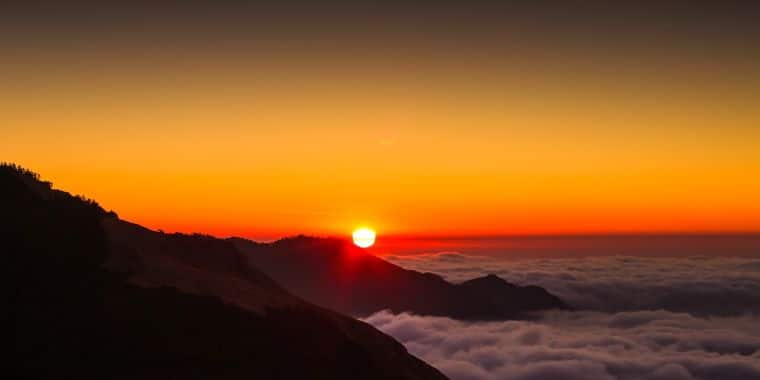
Mental preparation
Trekking is a fun, a recreational activity.
But at the same point, it can be exhausting!
As you might encounter with cold weather, surprising downpours, broken gear, and blisters.
These are some challenges you can face on the trail.
This is the time where you have to find something within yourself to keep going.
Giving up in the worst situation seems simply easy but it’s all about your mind playing a game telling to give up.
Most of the time during trekking your body might be fine because you’ve done a lot of preparation, but your mind wants to play games.
Pushing yourself in such a situation is the most rewarding thing and at the end of the day, you’ll realize your achievement!
So it’s good to prepare yourself mentally for what is about to come across your trekking route.
However, you don’t need to take any tension that would only create a worse scenario.
You should be aware of what is possible. Learn about the trails, know what can happen, and how you can deal with it. For this, you can read trekking blogs, book, and talk with other experienced trekkers.
Thus, it’s really important to prepare yourself both physically and mentally. The rough terrain is a test for your both physical fitness and mindset.
So, prepare yourself with positive mindset along with good physical condition. This will actually ensure you are ready to experience all the wonders of Annapurna region.
Gear and Equipment
Now that you have prepared yourself physically and mentally, your Annapurna Base Camp Trek training is not complete without having the right gear and equipment.
Proper gear and equipment are key to a successful trek.
Trekkers must invest in quality hiking boots, proper clothing, good backpack and other necessary gear suitable as per the weather conditions during the trek.
Doing some research and preparing a checklist of essential items is necessary to avoid any last-minute oversights.
Let’s read further into more detailed information on gear and equipment required for successful and enjoyable Annapurna Base Camp trek:
Hiking Boots
Invest in a good pair of sturdy and comfortable hiking boots with ankle support. These will be your most crucial gear during the trek.
Make sure to break them in before the trip for comfortable walk and to avoid blisters.
Clothing
Base Layers: Moisture-absorbing and quick-drying base layers are essential to regulate body temperature and keep you dry during the trek.
Choose lightweight and breathable materials.
Insulating Layers: Pack warm, insulating layers like fleece or down jackets to keep you warm during chilly nights and at higher altitudes.
Outer Shell: A waterproof and windproof jacket is vital to protect you from rain and strong winds.
Invest in one that is waterproof and suitable for all seasons.
Trekking Pants: Lightweight, quick-drying, and comfortable pants are ideal for the trek.
Convertible pants (with zip-off legs) are a popular choice for trekking in Nepal, as they can be converted into shorts if it gets warmer.
Headwear: Wear a wide-brimmed hat or a cap to shield you from the sun and a beanie or a buff to keep your head warm at higher altitudes.
Gloves: Bring a pair of lightweight gloves to protect your hands from cold and wind.
Backpack for Solo Traveler and Duffel Bag for Organized Trips
A comfortable and well-fitted backpack is essential to carry your belongings during the trek.
Look for a backpack with padded straps and a hip belt to distribute the weight evenly.
It is recommended to purchase a backpack with a rain cover or waterproof liner to protect your gear from rain, snow, and dust, keeping your bag in good condition.
If you have booked your Annapurna Base Camp trek with us, don’t forget to ask for a duffel bag and keep your backpack or suitcase in the hotel in Kathmandu or Pokhara.
Sleeping Bag
Invest in a high-quality, season-appropriate sleeping bag rated according to the season.
If you are hiking in spring/monsoon season, get one that goes down to minus 4/5 degrees Celsius.
If it’s autumn, go for one that goes around minus 8/10 degrees Celsius.
And if it’s during winter, then it should handle cold temperatures dropping to minus 15/17 degrees Celsius.
Get yourself a lightweight and compressible sleeping bag for ease of carrying.
Trekking Poles or Hiking Stick
Trekking poles provide stability and reduce the strain on your knees during the descent,.
Hiking sticks are particularly helpful during steep sections of the trail.
Headlamp/Flashlight
A reliable headlamp or flashlight with spare batteries is essential.
You will need it at teahouses when you want to go to the bathroom at night or if you want to move around when it’s dark.
Also, if for any reason it gets dark during the hike, you will need it.
Additionally, if you are going on a sunrise trip, you will start hiking before sunlight, so a good headlamp is essential.
Water Bottles/Water Purification
Carry a water bottle with a capacity of about 1-1.5 liters.
You don’t have to carry water for the whole day as frequent stops are there to fill your bottle.
Staying hydrated is crucial during the trek.
Additionally, bring water purification tablets or a water filtration system to treat water from natural sources.
Some people don’t like the taste of water purification tablets, so make sure you bring some flavors to add to your water in that case.
First Aid Kit
Carry a basic first aid kit containing essentials like bandages, antiseptic ointment, pain relievers, blister plasters, diamox and any personal medications you may need.
If you are trekking as part of an organized trek, a basic first aid kit is carried by your guide.
Toiletries
Pack biodegradable soap, hand sanitizer, sunscreen and personal hygiene items in small, travel-sized containers.
Make sure you pack toilet paper as well.
Snacks and Food
Carry some lightweight, high-energy snacks like nuts, energy bars, and chocolates to keep your energy levels up during the trek.
It’s also a good idea to carry these items for a change of taste.
Miscellaneous Items
Include a Swiss army knife or a multi-tool, sunglasses with UV protection, a lightweight towel, sunscreen, camera, a charger for your devices, a power bank for days without electricity and a travel plug in case your charger has a different plug than the one found in Nepal.
Remember to pack light and only bring the essentials.
All teahouses along the Annapurna Base Camp trek route provide meals and accommodation, so you won’t need to carry excessive camping gear.
Properly preparing and organizing your gear will contribute to a more enjoyable and comfortable trekking experience in the stunning Annapurna region.
Extra Tips for Annapurna Base Camp Trek Training
- Take your own time. It’s essential to ascend gradually, especially when you’re facing a high altitude challenge. If you’re going for multi-day hiking, it’s good to hike higher areas during the day and then sleep lower at night.
- Drink plenty of water. Water is a key to reduce the altitude sickness symptoms. It’s necessary to keep yourself hydrated throughout the trail.
- Avoid drinking alcohol and caffeine. Drinking alcohol and caffeine will dehydrate you.
- Usually, the higher you hike it gets cold and this drop in temperature will affect your physical conditions. Weather can change rapidly in the Himalayas so always bring warm clothes. Also, while dressing, layering is highly recommended.
- If you are up for extra challenge, go for 5 days Annapurna Base Camp Trek.
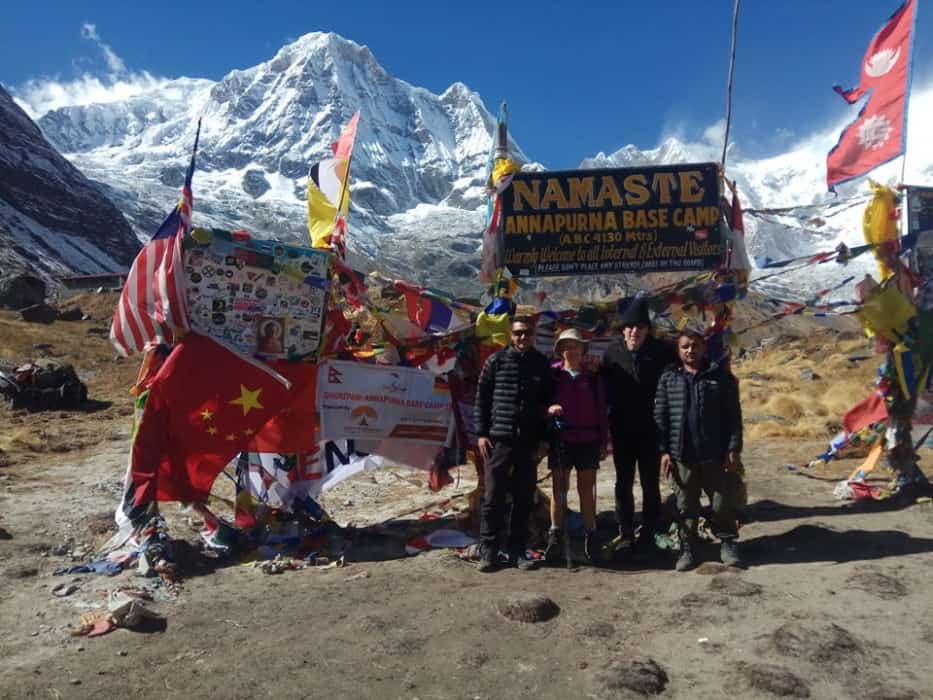
Benefits of Annapurna Base Camp Trek Training
- You’ll have more fun during your trek when you’re in a shape. You’ll feel strong which allows you to enjoy the beautiful sights rather than suffering during your trek. Just enjoy! You’ll surely have an amazing experience !!!
- When your muscles are strong enough, they’ll be ready to respond even if you slip on the varied terrain of the trail.
Final Thoughts
Annapurna Base Camp trek can be an incredible experience with an appropriate Annapurna Base Camp trek training plan.
Once you’re physically fit then all you need is a positive attitude and willingness to push yourself.
Besides all this, another main important thing is to allow your body to acclimatize to the altitude. More often, trekkers are not able to reach their final destination all because of altitude sickness.
As you might be walking through varied terrain, it is important to be fit. The fitter and stronger you are, the more you’ll enjoy your Annapurna Base Camp trek experience.
Challenge yourself, overcome your fears, and come and walk the famous Annapurna Base Camp trail!
If you have any questions about the Annapurna Base Camp trek training then feel free to contact us. We’ll respond to you as soon as possible.
Want more information? Send us your query, and our experts will get back to you within 24 hrs.

Madhav started working as a porter in 2001 and then moved on to work as a trekking guide. After working in the trekking and tourism industry for eight years, he co-founded Mosaic Adventure in 2009.
Madhav has trekked to most of the trekking destinations in Nepal, including Everest Base Camp Trek, Annapurna Base Camp, Annapurna Circuit Trek, Poon Hill Trek, Jomsom Muktinath Trek, Indigenous Peoples Trek, Langtang Valley Trek, Mardi Himal Trek, and all of the day hikes around Kathmandu.
He has also extensively traveled to other countries such as Australia, the USA, the UK, France, Hong Kong, Japan, China, the Philippines, the UAE, Saudi Arabia, Bahrain, Thailand, Turkey, and India. Madhav is the one who answers most of your questions about trekking and tours and helps to plan your trip by giving a personal touch.

